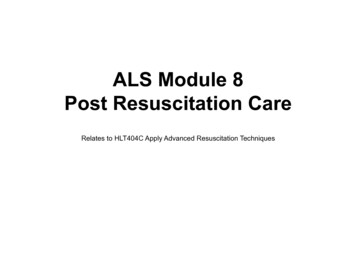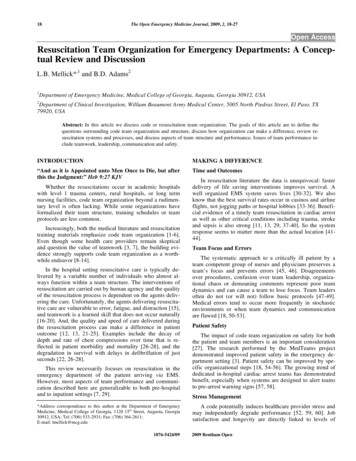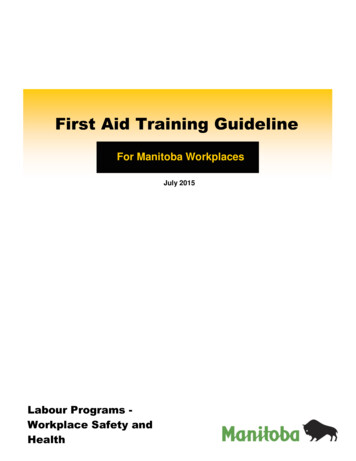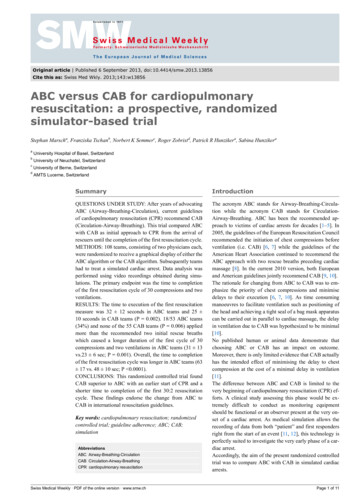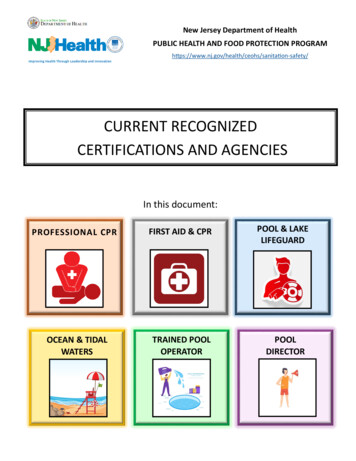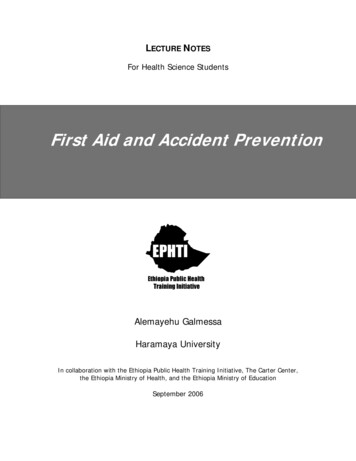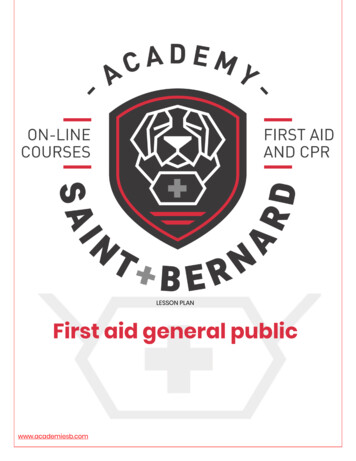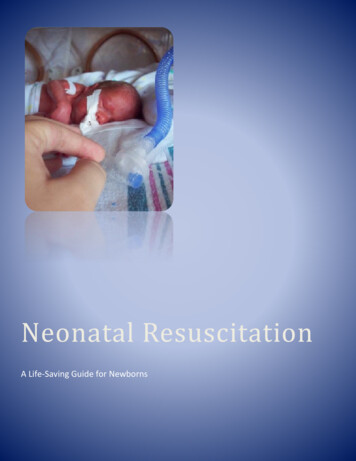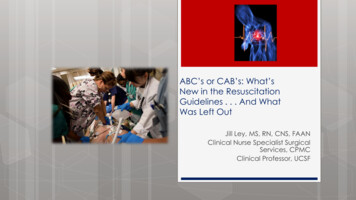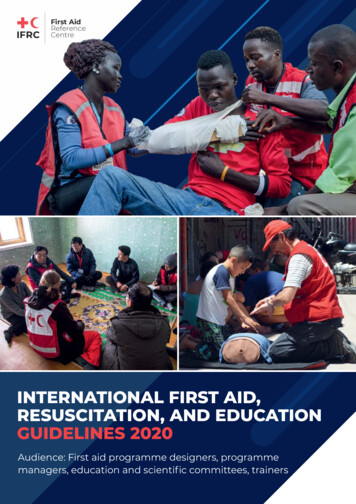
Transcription
First AidReferenceCentreINTERNATIONAL FIRST AID,RESUSCITATION, AND EDUCATIONGUIDELINES 2020Audience: First aid programme designers, programmemanagers, education and scientific committees, trainers
Red Cross Red Crescent NetworksCoordinated by IFRC Global First Aid Reference Centre International Federation of Red Cross and Red Crescent Societies, Geneva, 2020Copies of all or part of this study may be made for non-commercial use, providing the source is acknowledged.The IFRC would appreciate receiving details of its use. Requests for commercial reproduction should bedirected to the IFRC at secretariat@ifrc.org.The opinions and recommendations expressed in this study do not necessarily represent the official policyof the IFRC or of individual National Red Cross or Red Crescent Societies. All photos used in this study arecopyright of the IFRC unless otherwise indicated.Cover photo: IFRC, South Sudan Red Cross, Red Cross Society of the Democratic People’s Republic of Korea,Argentine Red CrossAddress: Chemin des Crêts 17, Petit-Saconnex, 1209 Geneva, SwitzerlandPostal address: P.O. Box 303, 1211 Geneva 19, SwitzerlandT 41 (0)22 730 42 22 F 41 (0)22 730 42 00 E secretariat@ifrc.orgInternational first aid, resuscitation, and education guidelines 20201303500 05/2016 Eglobalfirstaidcentre.org W ifrc.org
To know that the first aid programme ofthe National Societies is in accordance notonly to the state or local standards but alsoto international guidelines makes theGeorgia Red Cross Society first aid trainingmore attractive and trustful. Having theguidelines and other resources online, onone platform, will make our team’s workeasier and more effective.Tea Chikviladze, MD, First aid coordinator, Georgia Red Cross Society
Table of contentsACKNOWLEDGEMENTS 7FOREWORD 12INTRODUCTION 15About the Global First Aid Reference Centre 15About the 2020 Guidelines 16Definitions 18Global First Aid Reference Centre online platform 20Future development 20Process to develop the 2020 Guidelines 21Structure of the guidelines 22Scientific foundation 23Guidelines 24Key action 25Chain of survival behaviours 25Education considerations 26Evidence to action 28Adaptation 29Contextualisation 30Implementation 32EDUCATION Education strategy essentials 3535Chain of survival behaviours 35Principles of first aid education 36Theories relating to emergency response behaviour 36Contexts 38Conflict context 38Disaster context 42Water context 46Remote context 50Pandemic context 53Workplace context 56Education modalities 60Motivation to learn first aid 61First aid education for children 63Online learning for adults 67Online learning for children 70Blended learning 73Media learning 77Gamification 80Peer learning 83Video learning 88Feedback devices 92Refresh and retrain 94
FIRST AID General approach 99100General approach 100Hand hygiene 109Psychological first aid 113De-escalation techniques for violent behaviour 120Medication administration 122Oxygen administration 124Unresponsiveness 128Unresponsive and breathing normally 128Unresponsive and abnormal breathing (adolescent and adult) 134Unresponsive and abnormal breathing (baby and child) 147Unresponsive and abnormal breathing when a defibrillator is available 154Unresponsive and abnormal breathing with suspected opioid overdose 164Breathing problems 170Choking 170Breathing difficulties 175Asthma attack 180Croup 184Trauma 187Severe bleeding 187Chest and abdomen injuries 195Amputation 199Cuts and grazes 202Dental avulsion 206Blister 209Burns 213Flash eye 221Fractures, sprains and strains 223Spinal injury 228Head injury 233Acute lower back pain 238Mammal bites 242Insect bites or stings 244Aquatic animal injuries 250Snakebites 254Poisoning Medical conditions Chest pain 258264264Stroke 271Allergic reaction and anaphylaxis 279Shock 288Diabetic emergency 291Seizure 295Feeling faint 299
Fever 304Abdominal pain 308Emergency childbirth 313Sore throat 321Earache 324Headache 326Hiccups 330Environmental 332Hyperthermia 332Dehydration 337Hypothermia 343Frostbite 349Altitude sickness 352Motion sickness 356Decompression illness 360Radiation injuries 363Mental distress 366Traumatic event 366Suicidal ideation 371Acute grief 376GLOSSARY 382APPENDICES 389Red Cross Red Crescent global survey on first aid 2018 Resources 389396Safe classroom checklist 396CPR skills (for adolescents and adults) 397CPR skills (for baby or child) 398Choking skills 400Assess the scene 402Assess the person 404Access help 405Sexual and gender-based violence 406REFERENCES 408Education Education strategy essentials 408408Contexts 409Education modalities First aid 416425General approach 425Unresponsiveness 430Breathing problems 438Trauma 440Medical conditions 454Environmental 465Mental distress 469
AcknowledgementsThe International first aid, resuscitation, and education guidelines (referred to as the Guidelines) is aninternational publication made in collaboration with Red Cross Red Crescent Societies, first aid specialistsand task-forces. This collaboration of work by volunteers and staff is coordinated by the Global First AidReference Centre and a dedicated steering committee. The Global First Aid Reference Centre warmly thanksand values all these important contributions.Steering committee of the GuidelinesPascal Cassan, MDEmmy De Buck, PhDAndrew Macpherson, MDDon MarentetteDavid Markenson, MDEmily OliverKristopher TharrisThomas Wilp, PhDIFRC Global First Aid Reference CentreCentre for Evidence-Based Practice/Cochrane First Aid, Belgian Red CrossCanadian Red CrossCanadian Red CrossAmerican Red CrossBritish Red CrossCanadian Red CrossInternational Committee of the Red CrossGlobal First Aid Reference Centre project teamSalomé Boucif, First aid officerMaud Boutonné, International first aid attestation coordinatorDiane Issard, ManagerBassinte Ossama, Project assistantAdele Perkins, Platform manager (British Red Cross)EditorsChristine BoaseKeely SiegleBritish Red CrossAmerican Red CrossProofreadersGrace LoLéa MeunierChris PickinGlobal First Aid Reference CentreGlobal First Aid Reference CentreGlobal First Aid Reference CentreAcknowledgements 7
MethodologyJorien Laermans, PhDVere Borra, PhDCentre for Evidence-Based Practice/Cochrane First Aid, Belgian Red CrossCentre for Evidence-Based Practice/Cochrane First Aid, Belgian Red CrossIFRC Health and care department, GenevaEmanuele Capobianco, MD, MPH, DirectorBhanu Pratap, MBBS, MPH, Senior officer, Care in the communityContent contributorsEducationChristine BoaseBritish Red CrossNancy Claxton, EdDInternational Federation of the Red Cross and Red Crescent SocietiesDidier DusabeInternational Committee of the Red CrossKaysha EdwardsCanadian Red CrossAndrew FarrarBritish Red CrossPiers FlavinNetherlands Red CrossFelicity GapesNew Zealand Red CrossLamin GassamaGambia Red CrossAdam GesickiCanadian Red CrossEllen GordonBritish Red CrossPanagiotis Ioannidis, PhDInternational Committee of the Red CrossLesley JacobsonNew Zealand Red CrossBrian Kanaahe Mwebaze, PhD Uganda Red CrossLyle Karasiuk,Canadian Red CrossShelly King-Hunter (Longmore) Canadian Red CrossKatrina KissBritish Red CrossAlexander KuruczAustrian Red CrossAmbrose LeeSingapore Red CrossMoeketsi Augustinus Lethoko Lesotho Red CrossŽeljko MalićSlovenian Red CrossGeorge MamaboloSouth African Red CrossJodie MarshallCanadian Red CrossChristoph MeierSwiss Red CrossFabienne MeierSwiss Red CrossJoanna MuiseCanadian Red CrossJoe MulliganBritish Red CrossKristiina MyllyrinneFinnish Red CrossMalini Nair International Federation of the Red Cross and Red Crescent SocietiesCountry Cluster Delegation for the PacificMabvuto Ng’ambiZambia Red CrossMelisa PasqualiArgentine Red CrossAaron Orkin, MDUniversity of TorontoJeffrey Pellegrino, PhDAmerican Red Cross/University of AkronTyrone PowerCanadian Red Cross8 International first aid, resuscitation, and education guidelines 2020
Aaron PritchardCees van RomburghSandra SaburyChristopher ShirleyManeesh Singhal, MDOdd-Bjørn SørnesTracey TaylorDebbie Van’t KruisConrad WanyamaAlexander WardBritish Red CrossNetherlands Red CrossRed Cross Society of SeychellesBetsi Cadwaladr University Health BoardAll Indian Institute of Medical SciencesNorwegian Red CrossBritish Red CrossCanadian Red CrossKenya Red Cross/Kenya Medical Research InstituteBritish Red CrossClinicalKevin Hung, MBChBGabor Göbl, MDDaniel Meyran, MDCees van RomburghAxel Siu, MBChBSusanne Schunder-Tatzber, MDOwen Chauhan, MDJorien Laermans, PhDRed Cross Society of China - Hong Kong BranchHungarian Red CrossFrench Red CrossNetherlands Red CrossRed Cross Society of China - Hong Kong BranchAustrian Red CrossUniversity of OttawaCentre for Evidence-Based Practice/Cochrane First Aid, Belgian Red CrossCommunicationsMichael NemethMike SkinnerTracey TaylorLyle KarasiukRoger MayoCanadian Red CrossCanadian Red CrossBritish Red CrossCanadian Red CrossCanadian Red CrossPsychological first aid and mental distressEliza Cheung, PhDCherry LinKatie PavoniStijn Stroobants, PhDIFRC Reference Centre for Psychosocial SupportRed Cross Society of China - Hong Kong BranchBritish Red CrossBelgian Red CrossConflictMazen Al-Hebshi, MD, MPHWilliam ClucasMatthew EarlThomas Wilp, PhDRony TimoGonzalo Martinez JaraInternational Committee of the Red CrossInternational Committee of the Red CrossInternational Committee of the Red CrossInternational Committee of the Red CrossInternational Committee of the Red CrossInternational Committee of the Red CrossDisasterSteven JensenLauren Rogers BellGlobal Disaster Preparedness CenterGlobal Disaster Preparedness CenterAcknowledgements 9
Water safety and aquaticsDaniel GrahamLauren PetrassLinda Quan, MDLuis-Miguel Pascual-GomezReto AbächerliRoberto Barcala-Furelos, PhDAna Catarina Queiroga, PhDWilliam D. Ramos, PhDTom MecrowTeresa StanleyNile SwimmersFederation University of AustraliaAmerican Red CrossAsociación Española de Técnicos en Salvamento Acuático y SocorrismoSwiss Red CrossUniversity of VigoInternational Drowning Researchers’ Alliance/ EPIunit - Instituto deSaúde Pública da Universidade do PortoAmerican Red CrossRoyal National Lifesaving InstituteUniversity of AucklandImplementation meeting delegatesMilad ArjmandkiaIranian Red CrescentSantiago Camino BrancaArgentine Red CrossHenry OchoaEcuadorian Red CrossTea Chikviladze, MDGeorgia Red Cross SocietyFidelis De SousaMozambique Red CrossRasha El MasryEgyptian Red CrescentMartine FeronFrench Red CrossIbrahim GoulehPalestine Red CrescentEstella HumphreysBelize Red CrossSammy KamanuKenya Red CrossBrian Kanaahe, DPHUganda Red Cross SocietyRiaz KhanFiji Red CrossGaelle LelouxBelgian Red CrossMaya MahmoudLebanese Red CrossJeanne MukeshimanaRwanda Red CrossMalini Nair International Federation of the Red Cross and Red Crescent SocietiesCountry Cluster Delegation for the PacificCristina ParejaEcuadorian Red CrossRuru Ping International Federation of the Red Cross and Red Crescent SocietiesCountry Cluster Delegation for East AsiaShyamalee RathnakumariSri Lanka Red Cross SocietyVon Ryan OngPhilippine Red CrossSandra SaburySeychelles Red CrossDaniela SchwenkGerman Red CrossSamir Smisim, MDSaudi Arabia Authority Red CrescentSingh Vanshree, PhDIndian Red Cross SocietyJosé Victoriano Méndez LaraVenezuelan Red Cross/International Committee of the Red CrossShemi WaldmanMagen David Adom IsraelXiaohua ZhangRed Cross Society of China10 International first aid, resuscitation, and education guidelines 2020
OrganisationsThe following organisations made significant monetary and in-kind contributions to enable the successof the Guidelines. Without these contributions, the Guidelines would not have been possible to produce.Organisations include: American Red Cross Aviva Plc (Global First Aid Reference Centre Platform) Belgian Red Cross, Flanders British Red Cross Canadian Red Cross French Red Cross International Committee of the Red Cross International Federation of Red Cross Red Crescent and Red Crescent SocietiesThe participation and past or present evidence-based work of the following organisations and agencieswere invaluable in the development of these guidelines: Belgian Red Cross, Centre for Evidence-Based Practice (CEBaP) European Resuscitation Council IFRC Global First Aid Reference Centre IFRC Reference Centre for Psychosocial Support International Liaison Committee on Resuscitation (ILCOR) Scientific Advisory Council of the American Red CrossWe would like to thank the health teams of the IFRC regional offices who helped in coordination of theimplementation meeting.We wish to acknowledge the first aid managers, trainers and volunteers who will implement this informationin the programmes they design and deliver, and the countless individuals who will use this information andskills to save lives.Acknowledgements 11
ForewordAs we publish these Guidelines, I reflect on the global scale of the COVID-19 pandemic, the increasingincidence of disasters due to climate change, and the unprecedented levels of displacement of peoplebecause of conflict, violence, and disaster. I also reflect upon the capacity of National Societies to addressdiverse public health needs and to help people cope in times of crisis.Central to our response to these challenges is the need to preserve life, alleviate suffering, prevent furtherillness or injury, and promote recovery. First aid was the foundation stone of the Red Cross Red CrescentMovement and though the world in which we operate has changed dramatically, first aid remains as relevantas ever.When any crisis occurs, citizens are the first to respond and help those affected. Their ability to respondeffectively is, therefore, an essential ingredient whether the crisis is global, local, or personal. We knowfrom individual testimonies from first aid responders that “every minute counts” in crises. We mustcontinue to support the role of citizens as first aid responders and equip them with the skills andconfidence to save lives.For over 150 years, the Red Cross Red Crescent has been the leading trainer and provider of first aidin the world, upholding quality training standards, and developing evidence-based guidelines. All 192 RedCross and Red Crescent National Societies offer first aid training, education, and services. There are morethan 165,000 active first aid trainers serving their communities and making first aid available for all. It isthese strengths in experience and reach that put us in a unique position to develop people’s personal andcommunity resilience.12 International first aid, resuscitation, and education guidelines 2020
The 2020 International first aid, resuscitation, and education guidelines have been developed to supportfirst aid programme designers in updating their materials, education, and skills. The Guidelines arebased on the available evidence from the past two decades of publications and research and draw onour extensive experience, and best practices from subject matter experts and programme evaluations.The Guidelines represent our continued drive to better understand and advance the science behindeffective first aid education.Our Strategy 2030 envisions a global network of strong and effective local actors that mobilize for the goodof humanity and alleviate human suffering. In implementing these latest guidelines, our expertise in healthcan encourage wellbeing at all levels, including positive social, mental, and physical health, especially invulnerable populations. In doing so, we support individuals and communities around the world to cope withcrises, find hope and become more resilient.Sincerely yours,Jagan Chapagain,IFRC Secretary GeneralForeword 13
Tuvalu Red Cross
INTRODUCTIONFirst aid remains a core area of work of the International Federation of Red Cross and Red CrescentSocieties (IFRC) and the International Committee of the Red Cross (ICRC). The IFRC through the Global FirstAid Reference Centre is a major first aid educator and provider in the world. Almost all 192 Red Cross RedCrescent National Societies have first aid as their core activity.We believe first aid is a vital initial step for providing an effective and rapid intervention that can help reduceinjury and suffering and improve the chances of survival. Taking immediate action and applying appropriatefirst aid measures makes a difference. Having high-quality, evidence-based first aid education available topeople worldwide contributes to building safer and healthier communities by preventing and reducing risksin daily emergency, disaster and crisis situations.First aid is part of a common vision: to inspire, encourage, facilitate and promote humanitarian activities byalleviating human suffering and respecting human dignity. We believe everyone has the potential to savelives. First aid education and services are essential tools for achieving these goals.We advocate for first aid to be accessible to all and that at least one person in each household has access tolearning first aid regardless of their socioeconomic status or other potentially discriminatory factors.About the Global First Aid Reference CentreThe IFRC Global First Aid Reference Centre was established in 2012 as a Centre of Excellence. The ReferenceCentre is hosted by the French Red Cross and collaborates with 192 Red Cross Red Crescent NationalSocieties as well as scientific bodies, academic institutions and private sectors.The Reference Centre aims to reduce the number of deaths and the severity of injuries by supportingNational Societies to scale up and improve the quality of first aid education and services. It works closely withNational Societies to facilitate knowledge sharing and to promote good practice.To ensure the IFRC first aid is evidence-based and remains relevant to national and local contexts, the ReferenceCentre works with National Societies’ first aid, medical and education experts, the ICRC, and participates innumerous studies and research. The IFRC International first aid and resuscitation guidelines 2020 is a keyoutcome of such an effort.Number of people reachedIn 2018 at least 20 million people were trained in first aid by Red Cross Red Crescent National Societiesaccording to the 2018 survey carried out by the Reference Centre. 100 out of 192 National Societiesresponded to the survey. Around the globe there are more than 1,650,000 active first aid trainers (SeeAppendix 1 for data: Global survey 2018 data on first aid).Every year more than 100 Red Cross Red Crescent National Societies participate in the World First AidDay on the second Saturday of September. During this event, more than 900,000 volunteers and staffare mobilised and reach out to millions of people through social media and public events. With all thoseinitiatives, more than 46 million people are reached by Red Cross Red Crescent National Societies with firstaid and preventive health information.Introduction 15
About the 2020 GuidelinesThe International first aid, resuscitation and education guidelines 2020 evaluate and report on the scienceand good practice behind first aid, resuscitation and education. The 2020 Guidelines have been producedwith the main goal of fostering harmonisation of first aid practices across the Red Cross Red CrescentMovement by providing a strong evidence-base. This includes working in collaboration with the ICRC andharmonising practices where appropriate. This forms a key part of the quality assurance that people receivefirst aid education in accordance with IFRC international guidelines. These guidelines become the commondenominators for the IFRC to establish its International first aid attestation.The International first aid attestation is another priority of the Global First Aid Reference Centre. It is a continuousquality improvement process and recognition, awarded when first aid training provided by a Red Cross Red CrescentNational Society is consistent with the latest IFRC International first aid, resuscitation and education guidelines.The Guidelines do not replace first aid manuals and associated educational materials. Instead, they serve as thefoundation resources for first aid programme designers to develop their first aid materials such as manuals,programmes, courses, learning apps, digital products, public information, and associated educational materials.National Societies should use and adapt the Guidelines according to their local cultural, linguistic, technological,environmental and legal contexts, including the local prevalence of injuries and illnesses. The adaptation mustalso consider the populations’ capacities and available resources. In addition, the Guidelines provide scientificevidence for first aid programme managers and designers to make strategic decisions.Figure 1:. Linking the 2020 Guidelines and the MovementSCIENCEStructuraldisseminationLocal 6INTERNATIONAL FIRST AID, RESUSCITATION, AND EDUCATION GUIDELINESGlobal DisasterPreparednessCenterIFRC first aidprogrammesand resourcesNATIONAL SOCIETIES(adapt for socio-cultural, legal,technological, economic,or environmental factors)First aid trainingand educationFirst aid products(e.g., manuals, apps) International first aid, resuscitation, and education guidelines 2020ICRC first , armed conflict& violence)First aid services(e.g., event first aidor ambulances)
First aid educationThrough engaging with first aid education and the fundamental principles of the IFRC, we reinforce valuesof humanity by giving people skills, confidence and willingness to help. It is the role of the Movement tochampion first aid education as a universal means to help people engage in more helping behaviours andto live more safely, be more resilient, and provide care when needed.The Movement views first aid as one of the greatest humanitarian acts for which first aid education hasan integral part in building personal and communal resilience. As such, it is the duty of the Movement toadvocate for and provide effective first aid education that is of the highest quality, affordable, and accessibleto everyone.The Movement’s effectiveness will be magnified if first aid actions are recognised and encouraged byhealthcare professionals. Embedding first aid education into national health policies and culture, both as alife skill that is learned by all, and a resilience and emergency response tool that is recognised as a vital partof health systems is an important role for the Movement. The 2020 Guidelines promote evidence-basedpractice as the foundation for first aid education by ensuring that the best available scientific evidence iscombined with the preferences and resources of the target group and practical experience and expertiseof experts in the field.Link to IFRC’s Strategy 2030First aid is central to the five global challenges identified in the IFRC’s 2030 strategy: Climate and environmental crises: first aid as a resilience enabler allows communities to prepare forand respond to local climate-related emergencies. Evolving crises and disasters: first aid education develops communities’ capacity to respond, aimingfor first aid for all and having at least one person trained in first aid per household. Growing gaps in health and wellbeing: first aid empowers communities in prevention, healthpromotion and psychological first aid according to common injuries and health priorities. Migration and identity: first aid facilitates the inclusion of vulnerable people and migrants to learnfirst aid and save lives, regardless of their situation. Values, power and inclusion: first aid is an act of humanity, showing a willingness to save liveswithout discrimination.The Guidelines provide us with evidence and good practice in first aid knowledge, treatment and educationto achieve what is set out in the IFRC 2030 Strategy. By promoting and using proven first aid techniques toaddress key emergency-related injuries, we can build local communities’ preparedness and response capacity.Where do the Guidelines fit in IFRC’s first aid policy?In the IFRC’s first aid policy, it states that the IFRC supports National Societies and participates in thedevelopment of harmonised first aid techniques in accordance with scientific research, internationalstandards, good practice guidelines and measures of quality services. National Societies should developtheir first aid education and services using the most up-to-date, evidence-based guidelines and best practice.To support the policy implementation, the IFRC has set up alliances with scientific bodies, public healthexperts and pedagogical specialists in first aid and emergency response. As a result, the International firstaid, resuscitation, and education guidelines were first produced in 2011, then reviewed and enhanced in2016, and again in 2020.Introduction 17
In the 32nd International Conference of the Red Cross and Red Crescent 2015, a resolution was passed onthe legal aspects of first aid. It encourages States to consider all necessary steps to encourage the first aidprovision by laypeople with appropriate training, including, where appropriate, establishing protection fromliability for their good faith efforts and ensuring that they are aware of this protection. In order to collectivelyadvocate for this legal protection, the Guidelines are essential for the Movement to ensure its training andservices are good quality and based on the evidence-based, international Consensus on Science.A distinction is made between harmonisation and standardisation. The intention is not to have one techniquefor each situation, but rather to have a consensus on minimum agreed principles. This consensus is basedon a critical review of the available evidence and information learned from the experiences of the Red CrossRed Crescent Movement.DefinitionsFirst aid is the immediate assistance provided to an ill or injured person until professional help arrives. Itis concerned not only with physical illness or injury but also with other initial care, including psychosocialsupport for people who are emotionally distressed due to experiencing or witnessing a traumatic event.First aid interventions seek to preserve life, alleviate suffering, prevent further illness or injury and promoterecovery.First aid provider is defined as someone trained in first aid who should recognise, assess and prioritise theneed for first aid. The first aid provider provides care using appropriate competencies, recognises limitationsand seeks additional care when needed.This document refers to the ill or injured person requiring first aid as the person. First aid educators shoulduse the appropriate term according to their local contexts. This person may be described as the person inneed of care, patient, victim, casualty or other terms.Emergency refers to an incident where first aid is required. An emergency can be small or large and canhappen in a private or public space.Emergency medical services (EMS) signifies that the first aid provider should quickly access the nextavailable higher level of care. In some places, EMS may mean an ambulance service and hospital, while inothers it may mean contacting a local health worker or travelling to a field hospital. Programme designerswill need to adapt the language according to the local context in which it is used.First aid education is a programme developing behaviours, knowledge or skills in first aid procedures andtechniques. This programme has defined outcomes and is provided by qualified facilitators or publishedphysically or virtually.First aid services may provide first aid at public events or respond to potential emergencies, among others.These services are based on agreements established between local authorities, event organisers or localcommunities and the organisation providing the service.18 International first aid, resuscitation, and education guidelines 2020
Levels of first aid providerThe levels of providers available around the world vary considerably. The continuum below describes theincreasing level of training and responsibility of providers. The Guidelines support first aid, resuscitation, andeducation for the following levels of first aid provider.LevelDescriptionFirst aid trainingor responsibilityExample of careBystanderA bystander happens to bepresent during an incident thatrequires first aid, however, theymay not be directly involved. Abystander can provide basic careand follow specific instructionsfrom a higher level of support.No formal trainingAccess emergency medicalservice (EMS) and request care.A first aid provider can recognise,assess, and prioritise theneed for first aid, providingappropriate care.First aid education wascompleted at some point, butskills are likely not used regularlyor refreshed through training.A first aid provider shouldprovide care to their level oftraining. If there is not access tomedical care, a first aid providerdoes the best they can do.Contact EMS to request care ifrequired and provide first aidaccording to training.A designated first aider is similarto a first aid provider but alsohas some responsibility to act. Adesignated first aider is typicallyfound in a workplace; however,first aid is not their primaryresponsibility.First aid education and typicallysome context-specific training;typically, skills are refreshed andretrained regularly, and theyhave opportunities to practisewith some regularity.First aidproviderDesignatedfirst aiderContact others (first aider, EMS)to request care.Contact EMS to request care ifrequired and provide first aidaccording to training. Documentcare provided.Vary significantlyby National SocietyMaintain direct pressure on ableeding wound as directed.Do CPR on a person that doesnot show signs of circulation.Apply a splint to an injured limb.Provide care for a chemical burnaccording to the specific MaterialSafety Data Sheets (MSDS) in theworkplace.Removal of fishhooks from aninjured pers
8 International first aid, resuscitation, and education guidelines 2020 Methodology Jorien Laermans, PhD Centre for Evidence-Based Practice/Cochrane First Aid, Belgian Red Cross Vere Borra, PhD Centre for Evidence-Based Practice/Cochrane First Aid, Belgian Red Cross IFRC Health and care department, Geneva Emanuele Capobianco, MD, MPH, Director
